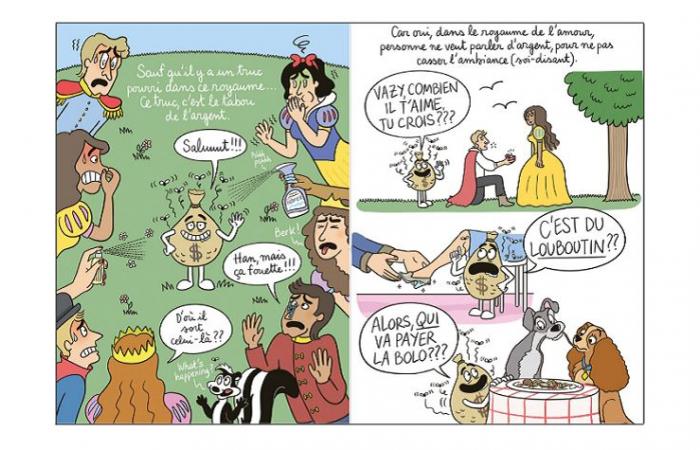Titre : The price to pay
Text : Lucile Quillet
Drawing : Tiffany Cooper
Editor: Leduc Editions
Publication date: October 16, 2024
Genre : Sociology
The Price to Pay is a comic book adaptation of the book The Price to Pay, what straight couples cost women by its own author Lucile Quillet and by illustrator Tiffany Cooper. Between them, they investigate to try to understand what the different points of passage of the hetero couple weigh on women, namely: flirting, starting a household, contraceptive burden, parental burden, if there is a child, etc. ., then separation (since one in two couples separate) and even ending with widowhood.
The authors have fun bringing us into the fabulous world of the couple thanks to the regular intervention of different characters: Cupid who walks around with his buttocks exposed and who has rabbits constantly asking us to find underwear and put them on , rabbits therefore, a bald and paunchy uncle embodying… the bald and paunchy uncle with very heavy jokes, a Marianne who wonders how we got there or even Napoleon Bonaparte, not known for his feminism. Thus, the various themes are each time made a little lighter by the constant humor.
Because the general observation is quite bleak: women are fooled, in almost everything. The heterosexual couple is a form of slavery that does not speak its name, and the only one who gets anything out of it, financially speaking, is the man. Here, I exaggerate the point on purpose, but in fact, the authors detail to what extent the introduction of heterosexual conjugality causes women to lose money, and that nothing is thought of, in current society, for the as a non-traditional couple. Women who enter into a relationship lose because the laws always tend, even insidiously, to favor the man, the breadwinnerthe one who takes care of bringing the money home while his wife works part-time to manage the children. If the observation does not necessarily seem new, it still seems very current.
As the rabbits and Cupid themselves comment, the authors dampen the mood until the end. They try to end up with a utopian and ideal view of society which would allow us to escape from this pattern, a view in which it is difficult to believe, given that they then leave their sociological and scientific clothes to put on a evaporated rainbow care bear cape, without concrete action plans to put in place in everyday life.
If the rabbit and Cupid are right, the comic strip being a long list of things and especially money that women lose by getting into heterosexual couples, the colors, drawings and graphics, simple and direct, still do that we are never sucked into a black hole of depression (I can write this perhaps also because I am a man). Humor here serves as the politeness of despair. And it is all the more despairing since it is still current, in 2024, that women lose, daily and throughout their lives, time, money, care for the men who accompany them, and all the more so since one in two couples separate (and women lose more in the process, financially speaking). The comic strip, superimposed on the novel and thus reaching more people, will perhaps allow a slow awareness of the matter as well as a possible perspective of change.






